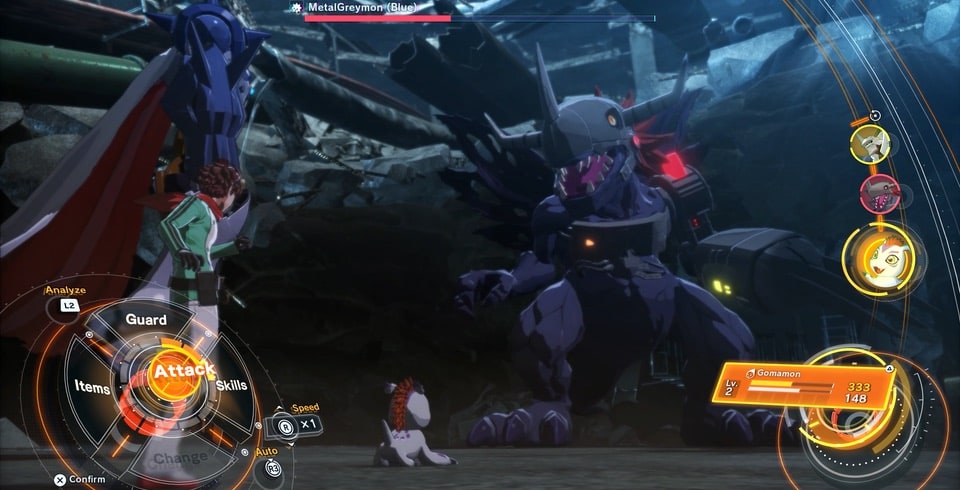I’m going to be honest here, I adore the Digimon games. Both Cyber Sleuth and Hacker’s Memory were excellent games that let you push on with the story when you wanted to, or just choose to ignore it to make the most absurdly powerful Digimon your patience could manage. These aren’t world-changing games, they’re just a lot of fun, and the Digimon system of going up and down the evolutionary ladder to max out your stats and unlock new forms is one of the purest dopamine-delivery systems outside of Vampire Survivors. We’ve had to wait the better part of a decade for a sequel to those two games, but Digimon Story Time Stranger looks to continue that legacy.
It shouldn’t be a huge surprise that I’m besotted with Digimon Story Time Stranger. Not only does it bring back the core systems from the previous Digimon Story titles, but it also irons out some of the needless creases, and then wraps a completely absurd plot around it. Seriously, the story in this game involves time paradoxes, parallel worlds, and chosen ones. Not to mention that you seem to be playing as an in-universe anime character, it’s wild. The story doesn’t always hit, but it’s cosy in an old-school RPG sort of way.
In a time where the other creature collector behemoth is trying to shift across to real time battling, Time Stranger continues with the tried and true turn-based combat of previous games, but this time you can activate agent skills to power up your team or deal damage to your foes. You can also equip your Digimon with different skills you can swap around to make sure every Digimon has a range of options to use. Digimon have elemental types, but they also have categories, and those both interact to determine strengths and weaknesses, so you really want a wide mix of options on your side.
As you fight, you level up and also get more information on enemies. You can eventually convert the scanned info from enemies into actual Digimon, and you can then use them and level them up, send them to the farm to train them there, keep them on your reserve team, or keep them in your bank, where they’ll still get experience points as you fight too. Of course, you can also feed them to other Digimon to make them stronger too, which is a nice way to use the excess you’ll end up with, so long as you don’t think about it too much.
You can then digivolve your critters once they’ve got the right stats, and once your Agent Rank is high enough – this essentially just goes up as you do more quests. To reach that tipping point, your creatures get passive boosts from fighting, of course, but also from the act of digivolving and de-digivolving back to previous forms. It means your monsters are constantly going up and down the evolutionary tree and exploring new branches in a way that’d make Darwin vomit… which is nice? You can now handle this from the menus whenever and wherever you are, instead of always having to return to the hub. This makes it all feel a lot smoother, and with all the gains you get elsewhere, you can basically ignore the Digimon Farm completely if you want to.
To take a brief break from all the compliments, there is some weird monetisation built into Digimon Story Time Stranger. Beyond what is promised for the DLC season pass, there are special dungeons you can go into that apparently give loads of experience, gold, and materials, but you have to buy them separately and they weren’t available before launch for us to dig into. I don’t love it, and the only saving grace is that you really don’t need these dungeons to make good progress.
Visually, the game’s gorgeous. It’s got a lovely anime style to it, and the variety of environments you visit is incredible. You’ll see all sorts of biomes and get to talk to a preposterous number of Digimon as well. It sounds amazing too, as the soundtrack changes with each area and really helps set the tone. It’s not bouncing light beams all over the place, but I really like it.
Along with all of that, the ability to speed up fights and even automate them allows you to treat this more like a management game if you want to. It certainly helps you to race through some of the grind, in a way that has often been retrofit into JRPG remasters. As a distraction, there’s even a card game in it you can muck about with, though it’s not especially deep and probably won’t keep you distracted from the main focus of raising and battling Digimon. Let’s be honest, that’s the main reason you’re here, isn’t it?







This review captures the charm of the Digimon series beautifully! It’s great to see how the game balances old-school elements with modern features. Looking forward to diving into this one!
I completely agree! The blend of nostalgia and modern gameplay elements really enhances the experience. It’s interesting how the character development in this new title seems to take cues from previous games, adding depth to the story.
Absolutely! It’s great how the game captures that classic Digimon feel while also introducing new mechanics that keep it fresh. The character development and story depth add a nice layer too, making it appealing for both old fans and newcomers alike.
I completely agree! It’s impressive how they balance nostalgia with fresh mechanics. The updated graphics and storytelling really enhance the experience, making it appealing for both longtime fans and newcomers.
Absolutely, the graphics really enhance the experience while still paying homage to the original style. Plus, the storytelling elements seem to dive deeper this time, which adds a nice layer to the gameplay. It’s great to see how they’re evolving the franchise!
I totally agree! The blend of modern graphics with classic designs really captures the essence of Digimon nostalgia. It’s fascinating how the developers managed to keep the charm of the originals while also introducing new gameplay elements that appeal to both old fans and newcomers.
Absolutely! It’s impressive how they’ve managed to retain that nostalgic feel while incorporating new mechanics. The storytelling also seems to have evolved, making it more engaging for both old fans and newcomers alike.
I completely agree! The blend of nostalgia with modern gameplay elements really enhances the experience. Plus, the character development in these newer titles adds a fresh layer that keeps players engaged. It’s exciting to see how the series evolves while honoring its roots!
Absolutely! It’s interesting how the updated mechanics can make the familiar Digimon world feel fresh and engaging. Plus, the way they incorporate storytelling really adds depth to the gameplay. It’s like revisiting childhood favorites with a new perspective!